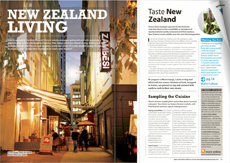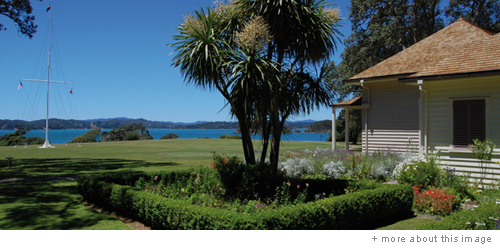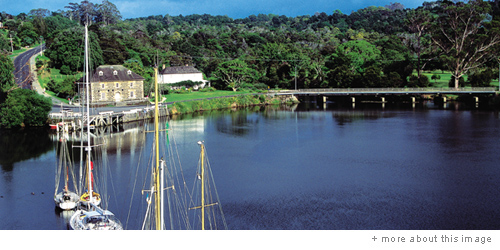New Zealand History
New Zealand’s human history may be short compared to that of other nations, but the mix of cultures that have influenced the course of history has resulted in a colourful heritage that ranges from magnificent carved Maori meeting houses to stone buildings.
 Maori are thought to have arrived in New Zealand over 1,000 years ago after travelling by canoe from a South Pacific homeland known as Hawaiki. They named their new home Aotearoa, ‘Land of the Long White Cloud,’ and developed a thriving society. The earliest Maori lived a hunter-gatherer existence but over time they settled into larger communities, growing kumara (sweet potato) and yams, and gathering birds, fish and shellfish. The Maori population may have been as high as 100,000 prior to European settlement.
Maori are thought to have arrived in New Zealand over 1,000 years ago after travelling by canoe from a South Pacific homeland known as Hawaiki. They named their new home Aotearoa, ‘Land of the Long White Cloud,’ and developed a thriving society. The earliest Maori lived a hunter-gatherer existence but over time they settled into larger communities, growing kumara (sweet potato) and yams, and gathering birds, fish and shellfish. The Maori population may have been as high as 100,000 prior to European settlement.
The first European to discover New Zealand was Dutch explorer Abel Tasman. On 13 December 1642 his ships sighted the Southern Alps and anchored in Golden Bay, near present-day Nelson. It was more than one hundred years later that Briton Captain James Cook visited New Zealand. On 6 October 1769 his cabin boy sighted land near Gisborne and Cook went on to circumnavigate and map the country.
New Zealand became a popular base for South Pacific explorers. Whalers, sealers and traders in timber and flax soon followed and by 1839 there were about 2,000 Europeans in New Zealand. In 1840 Captain William Hobson was sent to New Zealand as Lieutenant-Governor, charged with acquiring sovereignty through a treaty with Maori chiefs. On 6 February 1840, at Waitangi in the Bay of Islands, the Treaty of Waitangi was signed. Although there are continuing debates about the proper interpretation of the Treaty, it is considered New Zealand’s founding document.
Once New Zealand was a British colony, British migration accelerated, and gold rushes during the 1860s attracted more migrants. Independence from Britain was formally proclaimed in 1947 and in the 1970s a large number of Pacific Island immigrants settled in New Zealand. Today, New Zealand has developed its own unique culture – a mix of those who have settled the country throughout the centuries.
The Treaty of Waitangi
New Zealand’s founding document was signed by 40 Maori chiefs at Waitangi on 6 February 1840. The Treaty saw Maori cede sovereignty to the British Queen, affording them the rights of British subjects in return. Copies were circulated around the country and 500 chiefs had signed by September 1840.
Experiencing the Past
Travel back in time and unearth ancient traditions, colourful culture and rich heritage on your journey through New Zealand.
Museums New Zealand’s museums exhibit a vast array of fascinating collections and many offer interactive displays. The Auckland Museum is known for its Maori and Polynesian artefacts, while the Otago Museum focuses on the South Island’s history, and various local museums explore the Gold Rush era. Specialist museums display collections of classic cars, steam engines and planes, toys or fashion from days gone by. History comes alive at recreated pioneer towns like Shantytown, near Greymouth.
Heritage Trails Heritage trails are to be found in cities and rural areas and they may be included as part of a tour or self-guided (brochures for the latter are available at local i-SITEs). Especially renowned paths include Napier’s Art Deco Walk, Dunedin’s Heritage Walks, Wellington’s Old Shoreline Heritage Trail, the Otago Goldfields Heritage Trail and the Vanished World Trail in the Waitaki District.
Heritage Sites New Zealand’s most important heritage site is at Waitangi, but dotted around the country are other significant sites such as war memorials, Maori pa sites and abandoned mining settlements. Former gold-mining towns like the Arrowtown Chinese Settlement and the eerie ghost towns of Macetown and Bendigo in Otago, or once-bustling coal-mining towns like Denniston on the West Coast of the South Island are interesting places to explore.
Historic Buildings Historic buildings are all over New Zealand, but Art Deco Napier and Oamaru’s whitestone architecture are highlights. Auckland has grand old homes, while Wellington has the nation’s oldest suburb (Thorndon) and the world’s largest all-wooden structure; the 1876 Government Buildings. Many of Christchurch’s Gothic revival stone buildings were damaged in an earthquake on 22 February 2011 and their futures are still uncertain, but Dunedin’s historic gems such as Larnach Castle are not to be missed.
Cultural Encounters Tour operators such as Tamaki Heritage Experiences let visitors travel hundreds of years back in time over the course of an afternoon or evening. Engaging ceremonial rituals, re-enactments of history, powerful performance art and traditional Maori feasts offer a unique insight into long-ago times.
Timeline
Find out More
The Penguin History of New Zealand by Michael King (Penguin Books, 2003)
A History of the New Zealanders: From Polynesian Settlement to the End of the Nineteenth Century by James Belich (Allen Lane/The Penguin Press, 2001)
A History of New Zealand by Keith Sinclair. Fifth Edition. (Penguin Books, 2001)
A Traveller’s History of New Zealand and the South Pacific Islands by John H. Chambers (Interlink Books, 2004)
Kiwi Speak by Justin Brown (Random House, 2008)
New Zealand history online www.nzhistory.net.nz
New Zealand’s identity, stories, achievements and place in the world www.nzedge.com
The Encyclopedia of New Zealand www.teara.govt.nz
Te Manatu Taonga Ministry for Culture and Heritage www.mch.govt.nz
NZ news www.stuff.co.nz





 In September and October 2011 New Zealand will host the world’s third-largest sporting event – the Rugby World Cup. Approximately 70,000 international visitors are expected to attend, meaning that it is essential to book well in advance for accommodation and transport during this period. The event will include a nationwide festival showcasing New Zealand’s entertainment, arts, cuisine and lifestyle, so even if your clients are not sports fanatics, it will be an exciting time to visit.
In September and October 2011 New Zealand will host the world’s third-largest sporting event – the Rugby World Cup. Approximately 70,000 international visitors are expected to attend, meaning that it is essential to book well in advance for accommodation and transport during this period. The event will include a nationwide festival showcasing New Zealand’s entertainment, arts, cuisine and lifestyle, so even if your clients are not sports fanatics, it will be an exciting time to visit.  New Zealand Trade Manual has been designed with travel industry professionals in mind.
New Zealand Trade Manual has been designed with travel industry professionals in mind. 






